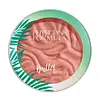What's inside
What's inside
 Key Ingredients
Key Ingredients

 Benefits
Benefits

 Concerns
Concerns

 Ingredients Side-by-side
Ingredients Side-by-side

Mica
Cosmetic ColorantPentaerythrityl Tetraisostearate
EmollientHydrogenated Vegetable Oil
EmollientOctyldodecyl Stearoyl Stearate
EmollientAluminum Hydroxide
EmollientAluminum Starch Octenylsuccinate
AbsorbentSilica
AbrasiveHydrogenated Polyisobutene
EmollientCaprylyl Glycol
EmollientEthylhexylglycerin
Skin ConditioningCaprylic/Capric Triglyceride
MaskingKaolin
AbrasiveLauroyl Lysine
Skin ConditioningEthylene/Propylene/Styrene Copolymer
Pentaerythrityl Tetra-Di-T-Butyl Hydroxyhydrocinnamate
AntioxidantSorbitan Tristearate
EmulsifyingButylene/Ethylene/Styrene Copolymer
Tocopherol
AntioxidantCI 77891
Cosmetic ColorantCI 45410
Cosmetic ColorantCI 77007
Cosmetic ColorantCI 15850
Cosmetic ColorantMica, Pentaerythrityl Tetraisostearate, Hydrogenated Vegetable Oil, Octyldodecyl Stearoyl Stearate, Aluminum Hydroxide, Aluminum Starch Octenylsuccinate, Silica, Hydrogenated Polyisobutene, Caprylyl Glycol, Ethylhexylglycerin, Caprylic/Capric Triglyceride, Kaolin, Lauroyl Lysine, Ethylene/Propylene/Styrene Copolymer, Pentaerythrityl Tetra-Di-T-Butyl Hydroxyhydrocinnamate, Sorbitan Tristearate, Butylene/Ethylene/Styrene Copolymer, Tocopherol, CI 77891, CI 45410, CI 77007, CI 15850
Talc
AbrasiveAlumina
AbrasiveMica
Cosmetic ColorantDimethiconol Stearate
EmollientIsostearyl Neopentanoate
EmollientAstrocaryum Murumuru Seed Butter
EmollientParfum
MaskingOctyldodecyl Stearoyl Stearate
EmollientPolybutene
Isopropyl Isostearate
EmollientLauroyl Lysine
Skin ConditioningAstrocaryum Tucuma Seed Butter
EmollientTheobroma Grandiflorum Seed Butter
Skin ConditioningTin Oxide
AbrasiveTocopherol
AntioxidantLecithin
EmollientAscorbyl Palmitate
AntioxidantGlyceryl Stearate
EmollientGlyceryl Oleate
EmollientCitric Acid
BufferingCaprylyl Glycol
EmollientHexylene Glycol
EmulsifyingPhenoxyethanol
PreservativeCI 77891
Cosmetic ColorantIron Oxides
CI 77492
Cosmetic ColorantCI 77499
Cosmetic ColorantCI 15850
Cosmetic ColorantCI 77007
Cosmetic ColorantTalc, Alumina, Mica, Dimethiconol Stearate, Isostearyl Neopentanoate, Astrocaryum Murumuru Seed Butter, Parfum, Octyldodecyl Stearoyl Stearate, Polybutene, Isopropyl Isostearate, Lauroyl Lysine, Astrocaryum Tucuma Seed Butter, Theobroma Grandiflorum Seed Butter, Tin Oxide, Tocopherol, Lecithin, Ascorbyl Palmitate, Glyceryl Stearate, Glyceryl Oleate, Citric Acid, Caprylyl Glycol, Hexylene Glycol, Phenoxyethanol, CI 77891, Iron Oxides, CI 77492, CI 77499, CI 15850, CI 77007
Ingredients Explained
These ingredients are found in both products.
Ingredients higher up in an ingredient list are typically present in a larger amount.
Caprylyl Glycol is a humectant and emollient, meaning it attracts and preserves moisture.
It is a common ingredient in many products, especially those designed to hydrate skin. The primary benefits are retaining moisture, skin softening, and promoting a healthy skin barrier.
Though Caprylyl Glycol is an alcohol derived from fatty acids, it is not the kind that can dry out skin.
This ingredient is also used as a preservative to extend the life of products. It has slight antimicrobial properties.
Learn more about Caprylyl GlycolCi 15850 is the pigment color red. It is an azo dye and created synthetically.
Azo dyes need to be thoroughly purified before use. This allows them to be more stable and longer-lasting.
This ingredient is common in foundations, lipsticks, and blushes. This color is described as brown/orangey red.
It has many secondary names such as Red 6 and Red 7. According to a manufacturer, Red 6 usually contains aluminum.
Learn more about CI 15850This pigment is called Ultramarine blue lazurite. It gives a saturated blue color, but can be used to create other colors as well.
According to the manufacturer, it is usually made from kaolin, sodium sulfate, sodium carbonate, sulfur, and charcoal.
Ci 77891 is a white pigment from Titanium dioxide. It is naturally found in minerals such as rutile and ilmenite.
It's main function is to add a white color to cosmetics. It can also be mixed with other colors to create different shades.
Ci 77891 is commonly found in sunscreens due to its ability to block UV rays.
Learn more about CI 77891This ingredient comes from a fatty acid (lauric acid) and amino acid (lysine). It is used to add a silky feel to cosmetics.
According to a manufacturer, its fatty acid base leaves a silky feeling on the skin. It also has emollient properties because of this. Emollients help soften skin by preventing water from evaporating.
Lauroyl lysine is barely soluble in water.
Learn more about Lauroyl LysineMica is a naturally occurring mineral used to add shimmer and color in cosmetics. It can also help improve the texture of a product or give it an opaque, white/silver color.
Serecite is the name for very fine but ragged grains of mica.
This ingredient is often coated with metal oxides like titanium dioxide. Trace amounts of heavy metals may be found in mica, but these metals are not harmful in our personal products.
Mica has been used since prehistoric times throughout the world. Ancient Egyptian, Indian, Greek, Roman, Aztec, and Chinese civilizations have used mica.
Learn more about MicaOctyldodecyl Stearoyl Stearate is created from stearic acid.
It is an emollient and thickens the lipid (oil) portion of a product. Due to its emollient properties, it may not be fungal-acne safe.
Tocopherol (also known as Vitamin E) is a common antioxidant used to help protect the skin from free-radicals and strengthen the skin barrier. It's also fat soluble - this means our skin is great at absorbing it.
Vitamin E also helps keep your natural skin lipids healthy. Your lipid skin barrier naturally consists of lipids, ceramides, and fatty acids. Vitamin E offers extra protection for your skin’s lipid barrier, keeping your skin healthy and nourished.
Another benefit is a bit of UV protection. Vitamin E helps reduce the damage caused by UVB rays. (It should not replace your sunscreen). Combining it with Vitamin C can decrease sunburned cells and hyperpigmentation after UV exposure.
You might have noticed Vitamin E + C often paired together. This is because it is great at stabilizing Vitamin C. Using the two together helps increase the effectiveness of both ingredients.
There are often claims that Vitamin E can reduce/prevent scarring, but these claims haven't been confirmed by scientific research.
Learn more about Tocopherol